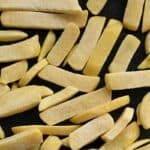When you’re cooking in the oven, it’s important to maintain a consistent temperature to ensure your food cooks properly. However, every time you open the oven door, heat escapes and the temperature drops. This can be a problem, especially if you’re cooking something that requires precise temperature control.
So, how many degrees does an oven lose when you open it? The answer depends on a number of factors, including the temperature of the oven, how long you leave the door open, and the size of the oven.
According to some experts, opening the oven door for just 30 seconds can cause the temperature to drop by as much as 150 degrees Fahrenheit.

How an Oven Works
An oven is an essential appliance in any kitchen that allows you to cook food by surrounding it with heat. Understanding how an oven works can help you make the most of it and cook your meals to perfection.
The Heating Element
The heating element is the part of the oven that produces heat. It can be either gas or electric, and it is located at the bottom or top of the oven. When you turn on the oven, the heating element starts to heat up and radiates heat throughout the oven cavity.
The Thermostat
The thermostat is the part of the oven that controls the temperature. It is usually located inside the oven and measures the temperature of the air. When the temperature drops below the set temperature, the thermostat signals the heating element to turn on and produce more heat. When the temperature reaches the set temperature, the thermostat signals the heating element to turn off and stop producing heat.
The thermostat is a crucial part of the oven that ensures that the temperature remains consistent throughout the cooking process. It is essential to use an oven thermometer to check the accuracy of the oven thermostat, as some ovens may have a variance of up to 30 degrees Fahrenheit.
When you open the oven door, heat escapes, and the temperature inside the oven drops. The amount of heat lost depends on how long you keep the door open and the temperature of the food inside the oven. It is essential to keep the oven door closed as much as possible to maintain a consistent temperature and prevent heat loss.
The Effect of Opening an Oven Door
Heat Loss
When you open the oven door, you lose heat. The amount of heat loss depends on how long you keep the oven door open and the temperature of the oven. According to experts, opening the oven door for even a few seconds can cause the temperature to drop by as much as 20-30 degrees Fahrenheit.
If you’re cooking a roast or baking a dish, the heat loss can affect the cooking time and the final result. The longer you keep the oven door open, the more heat you lose, which can lead to longer cooking times and unevenly cooked food.
The Impact on Cooking Times
Opening the oven door can have a significant impact on cooking times. When you open the oven door, the temperature drops, and the heating elements turn on to compensate for the heat loss. This can cause the temperature to fluctuate, leading to longer cooking times and unevenly cooked food.
If you’re baking a delicate dish like a souffle or a cake, opening the oven door can cause the dish to collapse. The sudden change in temperature can cause the air bubbles to burst, leading to a flat, dense cake or souffle.
When cooking in the oven, it’s best to keep the oven door closed as much as possible. If you need to check on your food, use the oven light or a timer to avoid opening the oven door unnecessarily. If you must open the oven door, do so quickly and close it as soon as possible to minimize heat loss.
Strategies to Minimize Heat Loss
Avoiding Unnecessary Door Openings
To minimize heat loss, avoid opening the oven door unnecessarily. Each time you open the door, heat escapes, and the oven temperature drops. Only open the oven door when necessary, such as when checking on the food or adding ingredients.
Using Oven Windows
If your oven has a window, use it to check on the food instead of opening the oven door. This will help to minimize heat loss and prevent the oven temperature from dropping. Make sure the window is clean and clear, so you can see the food inside.
Using Oven Lights
Some ovens have lights inside that allow you to see the food without opening the oven door. If your oven has a light, use it to check on the food instead of opening the door. This will help to minimize heat loss and prevent the oven temperature from dropping.

Using Thermometers
Using a thermometer can help you monitor the oven temperature without opening the door. Place the thermometer inside the oven and check the temperature regularly. This will help you adjust the oven temperature as needed and prevent heat loss from opening the door.
Using Oven-Safe Dishes
Using oven-safe dishes can help to minimize heat loss by reducing the amount of time it takes for the dish to heat up. Oven-safe dishes can withstand high temperatures and are designed to be used in the oven. Using these dishes can help to keep the oven temperature stable and prevent heat loss.
Overall, minimizing heat loss in the oven is important for baking and roasting. By avoiding unnecessary door openings, using oven windows and lights, using thermometers, and using oven-safe dishes, you can help to keep the oven temperature stable and prevent heat loss.
Factors That Affect Heat Loss
When you open your oven, you may wonder how much heat is lost and how it affects your cooking. Here are some factors that affect heat loss:
The Oven Model
The type of oven you have can affect how much heat is lost when you open the door. Convection ovens have fans that circulate hot air, which can help maintain the temperature when the door is opened. On the other hand, traditional ovens rely on radiant heat, which can escape more easily when the door is opened.
The Oven Temperature
The higher the oven temperature, the more heat is lost when the door is opened. This is because heat naturally moves from a warmer area to a cooler area. So, if your oven is set to a high temperature, opening the door will cause more heat to escape than if the oven is set to a lower temperature.
The Dish Being Cooked
The dish you are cooking can also affect how much heat is lost when the oven door is opened. A dish that is covered or has a lid will retain more heat than an uncovered dish. Additionally, a dish that is already hot, such as a casserole that has been cooking for a while, will lose less heat when the door is opened than a dish that is still cold.
Conclusion
Opening your oven door can cause a significant drop in temperature, which can affect the cooking time and quality of your food. The amount of heat lost depends on several factors, including the size and type of your oven, the length of time the door is open, and the temperature of the food.
According to Shirley O. Corriher’s book Bakewise, the oven temperature can drop 150° or more if the oven door is left open just thirty seconds. This can cause your food to take longer to cook and may result in uneven cooking. However, as Slate writer Brian Palmer points out, it’s impossible to control your oven temperature completely, so you shouldn’t worry too much about small fluctuations.
To minimize heat loss, you can try to avoid opening the oven door unnecessarily. If you need to check on your food, use the oven light or a window to peek inside instead of opening the door. You can also use a timer or thermometer to monitor the temperature of your food without opening the oven door.
It’s also worth noting that the temperature of your oven may vary from what you’ve set it to by up to 30 degrees in either direction, according to General Electric. This can be further influenced by opening the door, so it’s important to be aware of these fluctuations when cooking.
Overall, while opening the oven door can cause a drop in temperature, it’s not always a cause for concern. By being mindful of how often you open the door and taking steps to minimize heat loss, you can ensure that your food cooks evenly and thoroughly.





